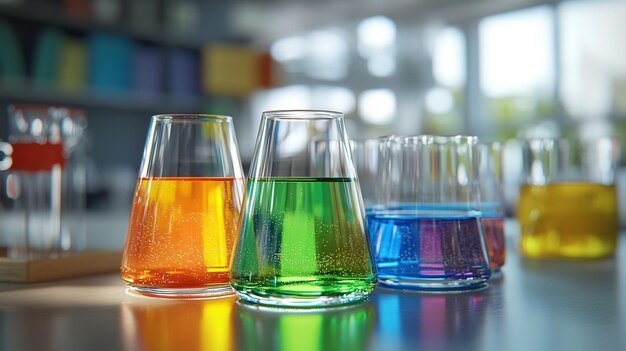Glass is an intriguing and versatile material found in a myriad of applications, from everyday windows to sophisticated laboratory instruments. Understanding the chemical composition of glass not only reveals its diverse functionalities but also enhances our appreciation of its role in modern technology. In this article, we’ll delve into the basic and complex components that make up glass, explore different types of glass and their uses, and examine the environmental and technological implications of glass production.
History of Glass Making
Glass-making is an ancient art that has evolved significantly over the millennia. The earliest glass artifacts date back to around 3500 BC in Mesopotamia. Ancient civilizations used natural glass, such as obsidian, and developed techniques to create man-made glass through melting minerals. As societies advanced, so did the sophistication of glass-making methods, leading to the diverse glass types we use today.
Basic Composition of Glass
Silicon Dioxide (SiO₂)
The backbone of most glass types is silicon dioxide, also known as silica. It’s the primary component that gives glass its strength and transparency. Silica sand is the main source of this compound, and it’s heated to high temperatures to form molten glass.
Soda (Sodium Carbonate)
Soda, or sodium carbonate, is added to the mix to lower the melting point of silica. This makes the glass easier to form and process. Soda contributes to the glass’s workability and affects its overall chemical stability.
Lime (Calcium Oxide)
Lime is used to stabilize the glass and enhance its durability. It helps prevent the glass from dissolving in water and improves its resistance to weathering and chemical attack.
Types of Glass and Their Chemical Composition
Soda-Lime Glass
Main Components
Soda-lime glass, the most common type of glass, consists of approximately 70-75% silica, 12-15% soda, and 10-12% lime. This composition is ideal for making windows, bottles, and jars due to its cost-effectiveness and ease of production.
Applications
Its widespread use ranges from household items to construction materials, making it a fundamental part of daily life.
Lead Glass
Chemical Properties
Lead glass, also known as lead crystal, contains lead oxide (PbO) which replaces some of the soda in the glass mix. This addition increases the glass’s refractive index, giving it a sparkling appearance and improved clarity.
Uses and Benefits
Lead glass is commonly used in fine glassware and optical lenses. Its enhanced brilliance and ability to be cut into decorative patterns make it a preferred choice for premium products.
Borosilicate Glass
Unique Features
Borosilicate glass is made with a significant amount of boron trioxide (B2O3), which provides it with excellent thermal resistance. This makes it ideal for use in laboratory glassware and cookware.
Common Uses
Due to its resistance to thermal shock, borosilicate glass is used in applications requiring high durability and temperature stability, such as in laboratory instruments and high-quality kitchenware.
Aluminosilicate Glass
Composition and Strength
Aluminosilicate glass includes aluminum oxide (Al2O3) in its composition, which enhances its mechanical strength and resistance to heat. This type of glass is engineered to withstand harsh environments and is used in specialized applications.
Industrial Applications
Often found in electronic devices and high-temperature applications, aluminosilicate glass offers durability and reliability in demanding conditions.
Additives in Glass Production
Colorants
Metal Oxides and Their Effects
Various metal oxides are used to color glass. For instance, copper compounds produce blue hues, while iron oxides can result in green or brown colors. These additives are carefully controlled to achieve the desired color and transparency.
Modifiers
Impact on Glass Properties
Modifiers such as barium oxide or magnesium oxide are added to alter the glass’s properties. They can enhance its chemical resistance, adjust its refractive index, or influence its hardness.
Stabilizers
Role in Enhancing Durability
Stabilizers like lead or zinc oxides are used to prevent glass from breaking down over time. They help maintain the glass’s clarity and structural integrity, particularly in demanding applications.
Environmental Impact of Glass Production
Energy Consumption
The production of glass is energy-intensive, involving high temperatures and prolonged melting processes. This high energy consumption contributes to environmental concerns, particularly in terms of carbon emissions.
Recycling and Sustainability Efforts
Fortunately, glass is highly recyclable. Recycled glass requires less energy to process compared to new glass, reducing overall environmental impact. Many glass products are made from recycled materials, contributing to sustainability efforts and reducing waste.
Modern Innovations in Glass Chemistry
Smart Glass Technologies
Recent advancements have led to the development of smart glass, which can change its properties in response to environmental conditions. This includes electrochromic glass that adjusts its tint or photochromic glass that changes color with light exposure.
Advanced Coatings and Treatments
Innovative coatings and treatments are enhancing the performance of glass. For example, anti-reflective coatings improve visibility, while self-cleaning surfaces reduce maintenance efforts.
Conclusion
The chemical composition of glass is a fascinating subject that intertwines with history, technology, and environmental science. From its basic ingredients like silica, soda, and lime to more complex variations like lead glass and borosilicate glass, the science behind glass production reveals a world of material versatility and innovation. As technology advances, the glass industry continues to evolve, addressing both performance and sustainability.
FAQs
What is the primary component of most glass?
The primary component of most glass is silicon dioxide (SiO₂), which forms the fundamental structure of the material.
How does lead glass differ from soda-lime glass?
Lead glass contains lead oxide, which enhances its refractive index and brilliance, making it more suitable for decorative purposes compared to the more common soda-lime glass.
Why is borosilicate glass used in laboratory equipment?
Borosilicate glass is used in laboratory equipment due to its high thermal resistance and durability, which makes it resistant to thermal shock and chemical corrosion.
What are the environmental concerns associated with glass production?
The main environmental concerns include high energy consumption and carbon emissions. However, glass recycling significantly mitigates these issues by reducing the need for new raw materials and lowering energy usage.
How is glass recycling beneficial to the environment?
Glass recycling conserves raw materials, reduces energy consumption, and lowers greenhouse gas emissions, making it a sustainable choice for managing glass waste.












